
Difference Between Kanthi Mala and Tulsi Mala
Share
Tulsi Mala and Kanthi Mala are revered spiritual accessories in Hinduism, often worn by devotees for their divine benefits. Though sometimes used interchangeably, these two malas have distinctive features, spiritual associations, and usage traditions. This article will explore the differences between Kanthi Mala and Tulsi Mala, their benefits, how they are used, and which one may be best suited for your spiritual practice.
🌿 What is a Tulsi Mala?
Tulsi Mala is a garland made from the sacred wood of the Tulsi plant (Holy Basil). In Hinduism, Tulsi is considered a manifestation of Goddess Lakshmi and is closely associated with Lord Vishnu and his avatars, especially Lord Krishna.
👉 Key Features of Tulsi Mala:
- Made from the stems or roots of the Tulsi plant.
- Typically consists of 108 beads.
- Used for chanting mantras and meditation.
- Worn around the neck or wrist.
✅ Spiritual Significance:
Wearing a Tulsi Mala is believed to purify the mind, body, and soul. It enhances spiritual growth and connects the wearer to divine vibrations. It is particularly beneficial for devotees of Lord Vishnu, Lord Krishna, and Lord Rama.
Popular Tulsi Mala Options:
- Blessed Tulsi Wood Mala for Peace and Spiritual Growth
- Organic Tulsi Beads Mala for Mind Body Soul Spiritual Practices
📿 What is a Kanthi Mala?
Kanthi Mala refers specifically to a type of double-stranded necklace made from Tulsi beads and worn around the neck. It is a significant ornament among Vaishnavas (followers of Lord Vishnu), especially in the ISKCON and Swaminarayan traditions.
👉 Key Features of Kanthi Mala:
- Usually consists of two or more rounds of Tulsi beads.
- Made as a close-fitting neckpiece.
- Symbolizes the surrender of the soul to God.
- Generally not used for chanting (unlike Japa Malas).
✅ Spiritual Significance:
Wearing a Kanthi Mala is a vow of devotion and surrender to God. It signifies that the wearer has offered their body, mind, and soul to the service of Lord Vishnu or Krishna. It is considered a protective shield against negative energies and is worn at all times.
Popular Kanthi Mala Options:
- Original Authentic and Exquisite Tulsi Kanthi Mala for Devotion and Wellness
- Tulsi Beads Double Round Kanthi Mala Handcrafted Sacred Prayer for Meditation and Spirituality
📌 Comparison Table: Tulsi Mala vs Kanthi Mala
| Feature | Tulsi Mala | Kanthi Mala |
|---|---|---|
| Material | Tulsi wood | Tulsi wood |
| Structure | Single-strand, 108 beads (Japa Mala) | Double or triple-strand (Necklace) |
| Use | Japa (chanting), meditation, wearing | Wearing as a religious symbol |
| Associated Deities | Lord Vishnu, Krishna, Rama | Lord Krishna, Vishnu (Vaishnav Sampraday) |
| Tradition | General Hindu devotees | Vaishnav (ISKCON, Swaminarayan) |
| Symbolism | Purity, devotion | Total surrender, spiritual protection |
🙏 Which One Should You Choose?
Choose Tulsi Mala if:
- You are looking to meditate or perform mantra chanting.
- You are a devotee of Vishnu, Krishna, or Rama.
- You want a spiritual tool for daily use.
Choose Kanthi Mala if:
- You belong to a Vaishnav sect.
- You want a constant reminder of your surrender to the divine.
- You seek divine protection and spiritual identity.
Both malas offer immense spiritual value and can even be used together—Tulsi Mala for chanting and Kanthi Mala for continuous wear.
🛒 Explore Authentic Tulsi and Kanthi Malas at Tulsi Rudra
- Blessed Tulsi Wood Mala for Peace and Spiritual Growth
- Organic Tulsi Beads Mala for Mind Body Soul Spiritual Practices
- Original Authentic and Exquisite Tulsi Kanthi Mala for Devotion and Wellness
- Tulsi Beads Double Round Kanthi Mala Handcrafted Sacred Prayer
May your spiritual journey be blessed and guided by the divine power of Tulsi. Whether you choose a Japa Mala or a Kanthi Mala, let your devotion remain firm and pure.
